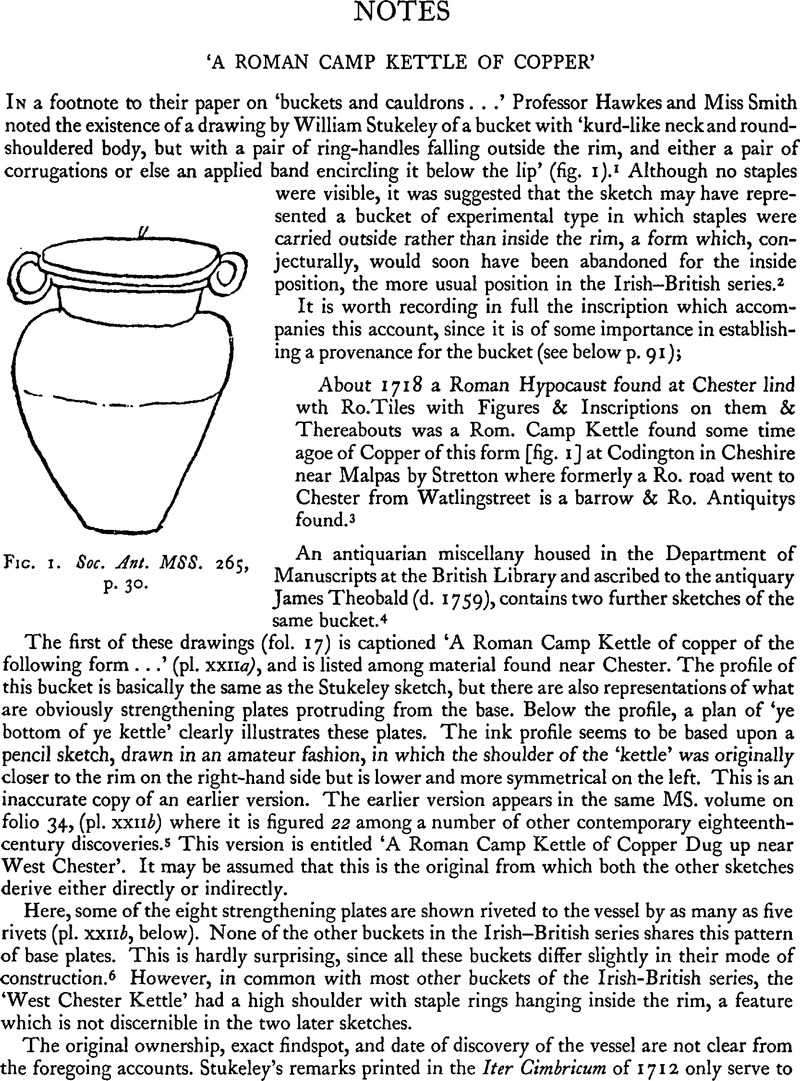No CrossRef data available.
Published online by Cambridge University Press: 29 November 2011

1 ‘On some buckets and cauldrons of the Bronze and Early Iron Ages’, Professor C. F. C. Hawkes and Miss Smith, M. A., Antiq. Journ. xxxvii (1957), 148Google Scholar n. 1, quoting Soc. Antiq. MSS. 265, p. 30. A further version appears in Soc. Ant. MSS. 264, p. 9, where the ring handles have been figured as classical volutes. This commonplace book is in the hand of Dr. Lort.
2 Hawkes, and Smith, , op. cit., p. 148Google Scholar.
3 The writer is indebted to Mr. John Hopkins, for kindly furnishing a photocopy of this folio, ‘Codington’ is obviously a contemporary rendering of Coddington, a hamlet situated to the south of Chester (O.S. SJ 4555).
4 B.M. Add. MS. 45663. For biographical information on James Theobald see Evans, Joan, A History of the Society of Antiquaries (1956)Google Scholar, passim. This miscellany is thought to date from circa 1720 to 1750 (see Barley, M. W., A Guide to British Topographical Collection (1974), p. 69Google Scholar) It comprises four main sections; a series of notes extracted from Gibson's Britannia (either 1695 or 1723); a descriptive and illustrative account of the opening of the barrows on Chartham Down, Kent, in 1730 by Dr. Cromwell Mortimer (cf. the version published by C. Roach Smith in 1856, editing Faussett's Inventorium Sepulchrale, pp. 160–8, the Theobald MS. being delightfully enhanced by the addition of polychrome drawings of the finds, now lost). An essay on various aspects of antiquity is accompanied by marginal sketches; and, finally, a number of small but detailed line drawings of artifacts which appear to have been later copied into this essay. The writer intends to discuss Dr. Mortimer's account elsewhere.
5 Many of these sketches would repay further investigation.
6 Op. cit., n. 1, pp. 137–60.
7 Stukeley, W., Itinerarium Curiosum (1725), vol. 1, pp. 51–61Google Scholar.
8 Ibid., p. 59.
9 Ibid., pp. 58–9.
10 Ibid., p. 59.
11 Ibid.
12 Loc.cit., n. 1.
13 SeePiggott, S., William Stukeley (1950), pp. 27–91Google Scholar, espec. p. 51.